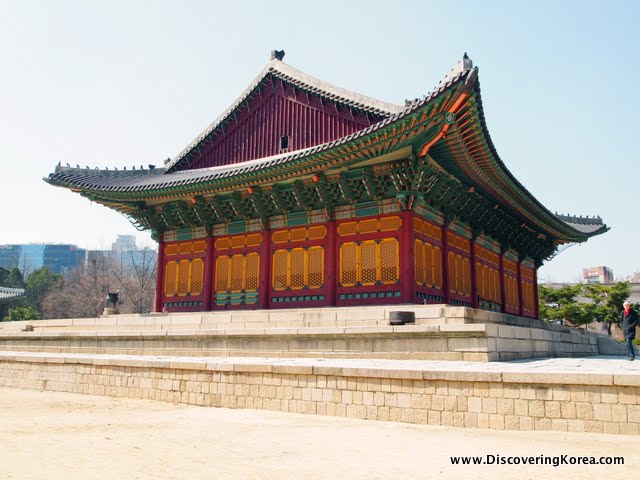A few months ago during a Royal Asiatic Society walking tour of Seoul’s palaces, I learned that before most of the city’s five grand palaces were burned or bulldozed, they formed Asia’s second largest royal compound (the largest was China’s Forbidden City).

Case in point is the “Palace of Virtue and Longevity,” better known as Deoksugung, or Deoksu Palace. Located in the middle of modern Seoul, it was built during the mid-1400s as a private villa for Prince Wolsan, the big brother of King Seongjong.
But when the Japanese invasion of 1592 left all of Hanyang’s (now Seoul) palaces burning, the residence was renamed Gyeongungung and converted into a temporary palace for just 7 years until Changdeokgung Palace became the royals’ primary residence.
The ole villa-cum-palace fell into disuse over the next 2+ centuries before it became Emperor Gojong‘s official residence in the 1890s. My guide estimated that at its height, Deoksugung was comprised of 180 structures, but most were either burned in a 1904 fire or demolished by the Japanese during the colonial period.
Today, only about 12 significant buildings remain on a footprint whose size is less than half its original. Nevertheless, what remains is a beautiful reminder of the sophistication of Korea’s Joseon period.
In the years immediately pre- and post Japanese annexation of Korea, the palace was the site of fascinating political intrigue and tragedy as Gojong and his remarkable wife, Empress Myeongsong, juggled the imperial designs of four world powers: China, Japan, Russia and the United States (such has always been Korea’s fate thanks to geography).
When the Empress was brutally murdered by the Japanese in 1895, Gojong went into safe-keeping at the nearby Russian Legation before returning to the palace in 1897 (albeit with a secret tunnel connecting his palace to the Russians).
But Japanese defeats of the Chinese in the 1894-5 Sino-Japanese War and the Russians in 1904-5, along with secret deals with the Americans and Brits (also in 1904-5), Korea’s fate was sealed.
At the conclusion of the Portsmouth Peace Conference in September 1905, Japan demanded that “Korea be placed at Japan’s free disposal.” In a desperate effort to preserve his country, Gojong sent a personal letter to U.S. President Theodore Roosevelt, who refused it.
Alone and at the point of a bayonet, in 1905 Gojong put the royal seal on Korea’s protectorate status. In 1907, he was forced to yield his throne to his mentally retarded son, Sunjong, whose reign and Korea’s 2,000-year-old monarchy ended when Japan annexed Korea in 1910.
Gojong continued to live at Deoksugung until his death on January 21, 1919. His passing inspired protests that grew into Korea’s “March 1st Movement.” Over the next year, two million Koreans across the peninsula protested Japan’s brutal colonial rule.
With the historical profile out of the way, let’s talk about the palace itself. I’ve always found Deoksugung’s random mix of architectural styles a little awkward.
Traditional Joseon Dynasty architecture is set alongside Greek/Roman revival next to a Japanese colonial-style edifice. It’s the only Korean palace I’ve seen to incorporate non-Korean architecture. Here are three highlights:
Jeukjodang
Three Korean monarchs ascended the throne here.
The throne room and audience hall is set atop a broad, 2-tiered stone terrace guarded by two tiger-ish mythical folk animals, called haetae. The original structure was larger and had two roofs (burned in 1904).
Seokjojeon
Built between 1900-09, it was designed by a Brit, though construction was supervised by all sorts of folks.
Originally planned for Gyeonghuigung Palace, Gojong received foreign envoys in the three-story, neo-classical building. Today it’s part of the royal museum.
Jeonggwanheon
This funky tea house was built in 1900 and designed by a Russian. Its iron railings are decorated with bats, deer and pine trees.
Gojong liked to listen to music, discuss current affairs, and drink coffee and tea here. Tragically, it was also where his young son, the crown prince Sunjong, drank an opium-laden drink intended for the king, which put the boy into a coma and resulted in brain damage.
If you visit Deoksugung, there’s lots else to see. The two-story Seogeodang Hall lacks the colorful paint and rounded pillars reserved for palaces and Buddhist temples.
The grounds also feature Korea’s first western-style garden and a large statue of King Sejong the Great. 3x daily (except Mondays) from February 15-December 31 you can watch a re-enactment of a changing of the palace guard.
For Your Information..
| Open: | 09:00-21:00 Closed Mondays. Free English guide tours Tues-Fri at 10:30 and on the weekends at 13:40 |
| Admission Price: | 1,000 won for adults, 500 won for youth and free for 65+, the disabled, and anyone who’s clad in a traditional Korean hanbok. |
| Address: | Take subway line 1 or 2 to City Hall Station (exit #2) |
| Directions: | Take subway line 1 or 2 to City Hall Station (exit #2) |
| Phone: | |
| Website: |
About Matt Kelley
Matt Kelly is native of the US Pacific Northwest and is half-Korean by ethnicity. He lived in Korea for five years and has written hundreds of travel guides for Wallpaper, TimeOut, the Boston Globe and Seoul Magazine and was a host for several different variety shows on Korean radio and television.
